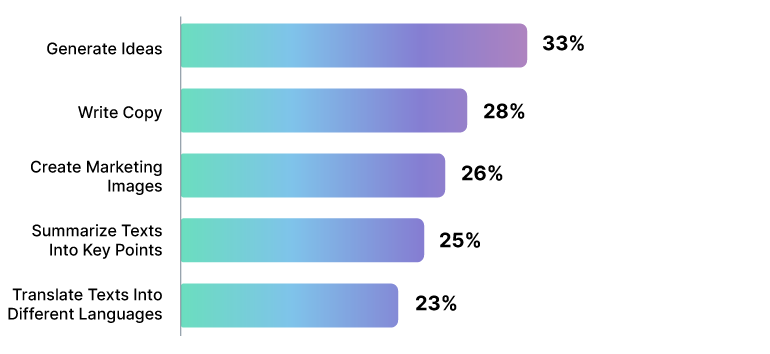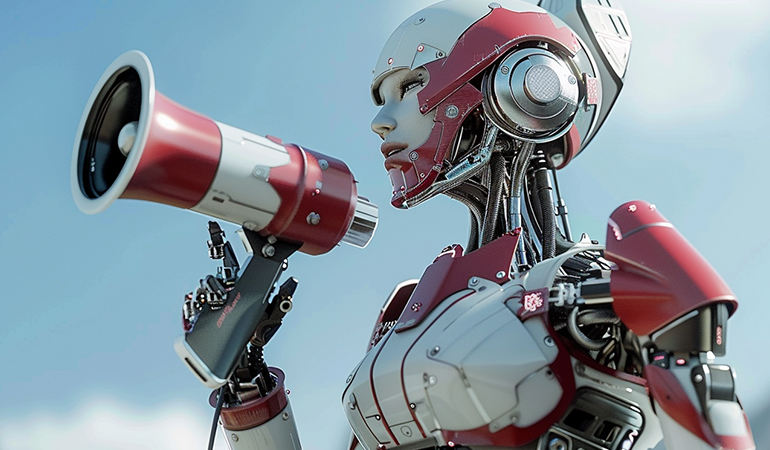Let’s face it: nowadays, hardly any product is unique. No matter the item, you will find dozens of brands competing in the same market sector. Today, it’s no longer enough to have a superb product, outstanding service, the most flexible policies, or the friendliest support. It’s all about marketing. Because without marketing, only you and your closest friends will know how great you are.
Doing business without advertising is like winking at a girl in the dark. You know what you are doing, but nobody else does.
Since ancient times, when craftspeople and later manufacturers first started to advertize their products, marketing (the way they knew it back then) has been getting increased attention. Like any sector, advertizing has been eagerly absorbing new technologies, leveraging them to deliver messages faster, clearer, and more precisely. The onset of the digital era signaled the arrival of digital marketing, which is growing by leaps and bounds and is predicted to reach a market value of US$807 billion by 2026.
From sophisticated analytics to IoT, the marketing industry adopts all the latest technologies it can lay its hands on to make advertisements better targeted and more personalized. Naturally, marketers can’t ignore the boom of artificial intelligence and have been testing various approaches to using AI in marketing to maximize profit.
The ways in which AI can be used in marketing are as numerous as the AI applications themselves. The explosive popularity of generative AI pushed marketers in the direction of exploring its potential in crafting all sorts of content — text, graphics, videos, and animations. However, content creation is just one of the many ways AI can help marketers engage with their audiences.
As a digital technology company, Intellias sees growing demand for artificial intelligence and machine learning solutions in various industries. Let’s dive deeper into how businesses use artificial intelligence in marketing to expand their customer base, increase brand recognition, and boost growth.
Chronicles of AI in marketing: industry size and forecasts
Putting aside marketing rhetoric, it’s the numbers that speak for themselves. The use of AI in marketing is growing, with the value of AI in this sector on track to reach US$107 billion worldwide by 2028. Generative AI, with its cornucopia of content creation options, gets its share of increasing attention, too – surveys show that as many as 75% of marketers are either actively using GenAI in their campaigns or are planning to do so in the near future.
Market value of AI in marketing worldwide from 2020 to 2028

Source: Statista
This trend, which we can rightfully describe as trailblazing and groundbreaking, stems from the amazing capabilities of AI to create highly personalized content in a matter of hours that it would have taken content writers weeks to create themselves. Sounds exciting, however, AI-generated content is still far from acceptable, let alone perfect. We’ve all seen people with six fingers on their hands in AI-created images and wondered at out-of-touch responses by ChatGPT.
Still, artificial intelligence can be a huge asset for marketers when used as a tool rather than a replacement for human effort. Its abilities to search for information and isolate trends and patterns, process unstructured data, and automate tasks can take personalization, audience segmentation, and campaign targeting to a new level, accelerating the marketing flows and enabling data-driven decision-making.
Based on the statistical data, we can safely say that the future of AI in marketing looks rather bright. The main driver of AI adoption in marketing is the ability of AI tools to assist with predictive analytics, forecasting customer behavior patterns and providing data for content personalization.
Generative AI will also thrive in the marketing sector. According to McKinsey, GenAI is expected to boost marketing productivity by 5% to 15% of total marketing spending. Indeed, its ability to accelerate and facilitate marketing content creation flows cannot be ignored.
Not everyone will lose their job to AI however people who do not utilize AI may lose their jobs to people who do.
AI game plan: use cases in digital marketing
As indicated by the numbers above, the use of AI in marketing isn’t just a lofty idea. As in other fields, AI is useful for analyzing marketing data thanks to its ability to quickly process massive amounts of information. When used in your marketing campaigns, an AI tool can significantly speed up and simplify efforts.

Content creation: smart, fast, and irresistible
Chances are you’ve already experimented with generative AI tools like ChatGPT or an AI image generator, tasking them with composing texts on various topics or creating images from your descriptions. From crafting narratives to suggesting synonyms and rephrasing text, AI has become instrumental in the content creation journey. It presents an exciting opportunity to streamline processes and refine every word to engage a wider audience. HubSpot claims that 79% of surveyed marketers recognize the potential of generative AI to improve content quality.
How marketers use AI: the top 5 methods

Source: Hubspot
Initially, the results of generative AI may seem promising, tempting you to delegate all content creation to an AI tool. However, when you ask AI to compose a complete social media post or blog article, more often than not, you’ll receive bland, unappealing text with little potential to engage your audience. Moreover, it’s important to consider the knowledge cutoff for an AI tool, as the data these tools can access is typically somewhat outdated.
Furthermore, the use of raw AI-generated content is already considered somewhat taboo. Together with AI-powered content creation tools, multiple AI detection tools are evolving to help you find out if content was generated by artificial or human intelligence.
A more effective approach is to use AI for generating ideas. According to HubSpot, “33% of marketers who use AI use it to generate ideas or inspiration for marketing content.” This is where it can truly be beneficial, suggesting topics and visual creatives that you can expand upon while incorporating your brand voice and style. You can experiment with blog topics, titles, calls to action, keywords, and video treatment and brainstorm with AI until you discover the perfect solution.

As in any other industry, the big question in marketing is whether AI will replace humans. Machine intelligence helps a lot with analyzing data, generating fresh pitching angles, and suggesting ideas for content that resonates with people. But when it comes to fields like social media and video production where personal judgment and critical thinking matter most, the human brain continues to be indispensable. Even though AI can simplify certain tasks, it can’t replicate people’s nuanced understanding and emotional intelligence. That’s why it’s unlikely that AI will completely take over for human marketers and creators.
The key is to find a perfect balance, with AI complementing human creativity and expertise. One good example is LinkedIn Collaborative Articles — an initiative aimed at building a community knowledge base starting with AI-generated topics that are then expanded and enhanced with insights of industry experts.
Customer segmentation: accurate, targeted, and effective
Segmentation means breaking down your customer audience into smaller groups for better targeting. You can segment customers by various criteria: age, occupation, geographic location, buying behavior, and so on. You can then target these groups with personalized content with the goal of improving engagement.
When AI comes into the picture, the methodology remains the same. It’s the speed and precision that change — and dramatically, too. When audience segmentation is done using artificial intelligence, machine learning, and natural language processing, customer data is analyzed almost in real time, allowing marketers to make validated decisions faster.
AI-powered segmentation tools can identify trends and patterns that may escape the human eye, track relationships, and predict customer behavior based on previous history. Moreover, the segments defined by AI can be narrower than those defined by human marketers, raising the effectiveness of targeted marketing activities.
Amazon leverages the data processing capabilities of artificial intelligence in Amazon Pinpoint, a cloud service designed specifically to assist marketers in better customer segmentation, targeting, and personalization. This ML-based service analyzes massive volumes of customer data, identifies behavioral patterns, and suggests the content that has the highest engagement potential.
Personalization: close, unique, and memorable

Today, it seems that if you so much as think about something, you will see an ad for it. For example, if you start researching the latest electric cars, you will soon start seeing ads for electric vehicles on social media and other sites. This is one example of personalized marketing.
Personalization is what customers want, so businesses have been focusing on this strategy striving to create content that resonates with specific groups of prospects. The personalization approach has turned out to be rather productive, and global revenue for customer experience personalization and optimization software is projected to reach more than US$ 9.5 billion by 2024.
Today, however, personalization alone seems insufficient. Customers no longer want to be targeted as a group; they want to be treated as individuals. This demand for extremely personalized experiences calls for a shift towards targeting individual customers — the hyper-personalization approach.
Hyper-personalization techniques create ultimately personalized experiences by displaying specific websites and ads or making dynamic pricing offers. Brands that explore hyper-personalization leverage the analytical capabilities of AI and ML to collect, process, and analyze various types of customer data, such as shopping and browsing history and social media activity, in addition to traditional demographic information.
AI can dynamically adjust hyper-personalization strategies by adding data from new customer activities and fine-tuning digital marketing content accordingly. As a result, brands achieve so-called segments of one, targeting each customer individually. This tactic has high potential for success, as personalization may be the purchase-driving factor for 80% of customers.
Netflix is one of the pioneers of hyper-personalization, using machine learning algorithms to create individual recommendations for each member profile. Based on viewing and search history, the streaming service chooses films to suggest, messages to send, and even art to display for each subscriber.
Competitive analysis: precise, clear, and insightful
Nowadays, no marketing campaign is launched without detailed research of the competition. However, manually collecting and processing intelligence on competitors can be extremely inefficient. Therefore, brands experiment with advanced technologies to accelerate and improve competitive analysis.
AI-powered tools add automation to competitive analysis, accelerating the process and improving the results. Specially trained large language models analyze competitors’ portfolios, special offers, pricing, customer reviews, and other data available in the public domain to put together complete company profiles.
As a result, you can get validated insights into your competitors’ market position, activities, partnerships, and innovations. Based on this information, you can identify your rivals’ strengths and weaknesses and find market opportunities for your business.
Mastercard uses AI-powered solutions for various purposes, including marketing research, competitive benchmarking, and portfolio performance analysis. The company offers AI consulting as part of its advisory offering aimed at helping clients sustain growth and secure their market position.
Predictive analytics: astute, strategic, and far-reaching
Predictive AI is among the most dynamically developing trends in the area of artificial intelligence. Predictive analytics has become a game-changer in the creation of marketing strategies, as it allows businesses to make informed data-driven decisions based on forecasts of future events and trends.
To build forecasts, predictive AI tools use historical data obtained from multiple sources to anticipate trends in customer behavior and demand. This methodology uses big data technologies to collect and process large volumes of raw data for use in predictive analytics. Advanced AI algorithms then use this data to build actionable insights into future events.
AI-powered predictive analytics lays the foundation for personalized marketing campaigns, precise customer segmentation, lead qualification, and overall optimization of marketing activities. Based on analytical data, marketers can expect lower customer churn and improved customer satisfaction and loyalty.
An interesting case of AI-driven predictive analytics is the use of AI models by JPMorgan Chase & Co. to analyze 25 years of Federal Reserve statements. The bank’s language model processes statements to identify signals of potential changes in monetary policies. JPMorgan Chase hopes to use this knowledge to better plan its future trading strategies.

Reaping the content, client, and ops benefits of AI for marketers
In addition to the obvious benefit of accelerating and streamlining manual operations, artificial intelligence and machine learning can give a boost to your marketing activities, contributing to success and growth. With an effective AI tool, you may see your digital marketing campaigns reach a new level of productivity and efficiency in more than one way. The ability to create original content, synthetic data, models of physical objects, and code to improve response times to customer engagement is creating opportunities for marketing innovation.
Higher customer engagement: reach and attract
Thanks to next-level personalization and segmentation, AI-generated content, notifications, and other marketing activities better engage with customers and might improve the conversion rate through more precise targeting.
More precise forecasting: analyze and engage
AI-powered analytical tools are capable of processing large amounts of historical and real-time data, building detailed and accurate forecasts of future marketing trends.
Marketing automation: draw and convert
AI marketing applications can automate lots of manual operations, speeding up results and freeing marketers’ time for more complex and innovative tasks. As a result, marketing processes become less time- and resource-consuming.
Validated decision-making: shape and act
Insights generated based on analyzing data obtained from various sources and processed by powerful artificial intelligence algorithms provide a solid foundation for marketing management decisions.
Increased ROI: personalize and maximize
Fine-tuned targeting and high personalization achieved as a result of using AI marketing tools may contribute to an increase in conversions and, ultimately, sales. As a result, brands can record fewer wasted ads and a higher rate of achieving marketing objectives, raising the overall return on marketing investments.
Integrating AI solutions in marketing: a defining moment
Now that AI has become more than just a passing trend, it’s time to focus on how to practically integrate it into marketing efforts to achieve tangible results. With various forms of machine-powered intelligence available, the question arises: which ones are most effective for enhancing your marketing operations?
To make the most of artificial intelligence, start with crafting a solid AI marketing strategy. Having a clear vision of your marketing goals will help you select the best tools and technologies for integrating AI into marketing efforts.
| Set marketing goals | Outline the ways in which you plan to use artificial intelligence and the goals you are focused on achieving. |
|---|---|
| Assess your marketing resources | Audit your existing marketing flows and processes to identify strengths, gaps, and bottlenecks that need to be meaningfully addressed by implementing AI tools. |
| Engage qualified professionals | Implement and customize your AI marketing solution. Engaging an expert in artificial intelligence, be it an in-house specialist or a trusted provider, will expedite the process and secure the expected results. |
| Choose the right tool | Pick solutions according to the goals you have set for your AI-powered marketing campaign. Consult a tech expert to make sure selected tools fit your purpose. |
| Balance automation and human involvement | Integrate AI tools and AI-generated content with human creativity to synchronize with brand values and resonate with the target audience. |
| Adhere to legal and ethical guidelines | Make sure that the solution protects customer data privacy and copyrights. Obtain consent for data usage and transparently communicate the use of AI in content creation to maintain ethical standards. |
| Analyze performance for tangible results | Improve marketing quality by analyzing performance. Consistently review engagement metrics, conversion rates, and audience feedback to pinpoint areas for enhancing AI-assisted content. |
| Train your team | Get your marketing teams up to speed with the new tool and set up training to kickstart use of AI-powered solutions for the desired results. |
AI in action: real-life examples of AI in marketing
Many different artificial intelligence technologies attempt to carry out tasks typically performed by humans, from recognizing voices and images to learning from data and sorting through text. Marketers are all about hyping the latest AI trends, like parsing images and audio or keeping data safe (and even targeting drones).
These trends sound cool but putting them into action is a whole other story. Still, AI offers tons of benefits for marketing and opens up bold new ways to shake up how marketing works. When AI and machine learning join the party, it takes marketing to a whole new level of productivity.
Brand performance evaluation with AI
A company specializing in generating industry insights leveraged artificial intelligence to get a deeper view of brand performance on the market. The implemented AI solution scans various online data sources, such as social media, news platforms, and communication channels, to collect and analyze references to the brand and evaluate its presence on the market.
The solution includes sentiment analysis, allowing marketers to determine whether the brand is mentioned in a positive or negative context. The resulting insights serve as the basis for reputational indices and detailed strategy recommendations.
AI-powered brand promotion and governance

A global retailer employs an AI-powered chatbot to train its sales personnel on presenting products to customers, enhance brand awareness, and drive product sales leads. The solution includes natural language processing capabilities to enable direct communication between the tool and its users. The chatbot is trained on the retailer’s extensive database to retrieve detailed information about a wide range of products. In addition to offering sales guidance, it evaluates the performance of trainees and provides comprehensive feedback, highlighting areas for improvement.
Deep learning for insurance marketing
In a bid to attract new customers for online auto insurance quotes at the lowest cost per acquisition (CPA), an AdTech company harnessed AI (particularly, deep learning) to forecast insurance consumer behavior and autonomously drive full-funnel marketing performance on a large scale. The campaign using deep learning technology yielded remarkable results, with a 28% increase in incremental sales — twice the client’s previous performance. Tailored deep learning models were developed to enhance programmatic display advertising by integrating data from various products, optimizing across offerings.
AI content creation tool to transform sales
eBay has found a way to make artificial intelligence do true magic. The AI-powered magical listing tool has reshaped the experience of eBay sellers, helping them create unique and accurate item listings in mere minutes. With this sophisticated tool, all a user needs to do to create a listing is upload an item photo. AI does the rest. The magical listing tool writes a title, description, and even some details relevant to the buyer that can be pulled from the photo. While this sounds easy, the solution is driven by powerful artificial intelligence and machine learning algorithms working to streamline and facilitate eBay sellers’ work.
Predictive AI models in retail
Walmart, one of the largest US retail stores, uses AI to enhance the shopping experience for its customers during holidays. Holiday shopping is often associated with stress and anxiety, and this is what Walmart engineers aimed to prevent with their AI-powered inventory management system.
Based on large volumes of data collected in multiple stores over time, the system can identify patterns in customer demand, pricing expectations, delivery preferences, and even routes within the store and customer behavior based on weather conditions. The AI/ML engines use this information to manage and adjust the retailer’s supply chain and logistics to make sure inventory is always in stock for holiday shoppers.
This AI-based predictive analytics system not only raises customer satisfaction in Walmart stores but also helps the brand optimize costs and inventory management by routing items to locations with the highest demand.
AI-backed predictive analytics for finance
Leveraging historical credit and debit card data to personalize targeted promotions through card-linked marketing, Cardlytics, a leading vendor in this field, uses customer segments termed “purchasegraphics” to match individuals with relevant deals based on spending behavior. These AI solutions prioritize privacy while ensuring accurate ad targeting by considering factors like demographics, purchase history, and seasonal trends. By effectively segmenting customers, banks and credit card companies can enhance customer loyalty and improve ROI, as evidenced by Bank of America’s success with the Cardlytics platform. This underscores the potential for AI-driven predictive analytics to optimize marketing strategies and drive profitability in the financial sector.
AI in marketing. Beyond the Ivory Tower
The railway isn’t finished yet. There’s still more to be done. The world will be encircled with iron and steam. Steam will do our work for us, and mankind will enjoy the benefits. There’s power and wealth at the end of this line.
It’s a sure bet that AI is here to stay, and it will clearly keep advancing in the years ahead. From monitoring media and analyzing data to creating content and SEO-driven campaigns and supporting customers, AI-powered marketing enables businesses to make more informed decisions, interact with their audiences more efficiently, and provide personalized experiences. Insights derived from AI lay the groundwork for growth and long-term success in marketing. Previously challenging tasks like sentiment analysis, natural language processing (NLP), and efficient use of virtual agents now shape how effectively businesses can achieve objectives, whether optimizing revenue or navigating unpredictable market conditions.
As we look to the future, markets are gearing up to offer personalized and captivating while secure experiences like never before. But there’s a challenge on the horizon: understanding the implications of AI and finding the perfect balance between privacy and personalization. And let’s not forget that AI innovation comes with its own set of uncertainties. That’s why it’s crucial to team up with seasoned AI consultants and engineers who truly grasp the ins and outs of AI adoption. Whether you’re aiming to revamp your marketing strategies or launch a groundbreaking startup, expert collaboration is the key to unlocking the full potential of AI in marketing.
Contact us to build custom AI solutions designed to propel your business to growth and success.





